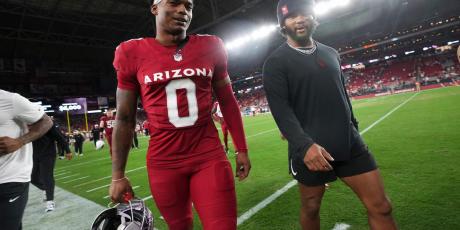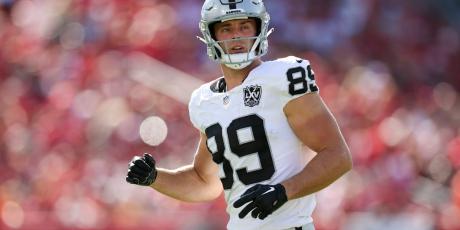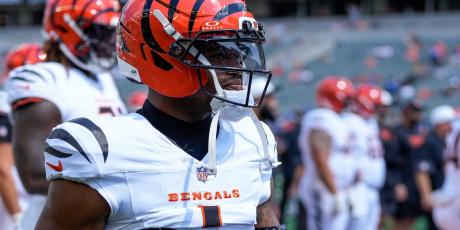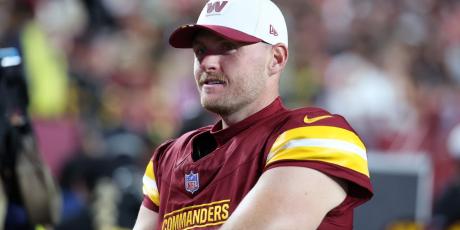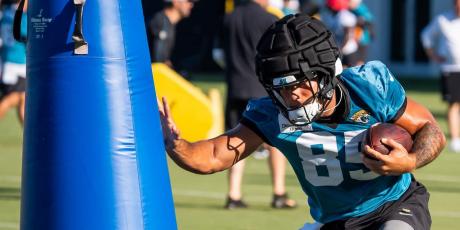How to Not Lose Your Fantasy Football League in the First Round

The first round of a fantasy draft typically contains fantasy’s top performers. Whether it be by talent or recency bias, we have to choose between some of the best players in the first round of our drafts. But, for as much fun and excitement there is making our first pick, it’s not without risk. If anything, it’s here (and in the subsequent early rounds) that can set us up for a championship run or have us increase our weekly number of DFS lineups.
Create or join a 2020 Yahoo Fantasy Football League for free today
The names are generally the same. ADP has essentially positioned the market in the first round with site-specific values pushing some names to the top. But those values aren’t set in stone. Draft trends have generated multiple narratives regarding how fantasy managers should build their teams. Regardless, even in the first round, opportunity cost should be a guiding factor even as we debate our first pick. I took a look at the historical results and pulled some high-level profiles for players drafted in the first round of PPR drafts. Depending on your draft slot, there may be an advantage to bucking conventional wisdom and looking at other positions to start off your draft.
Overview
Our approach should be simple. Leave the first round with an asset likeliest to meet their nominal or top-end projections for the season. But first, it’s important to understand the impact of a first-round pick. Our roster is a collection of players at multiple positions, but our first pick is what should anchor that squad for better or worse.

The cascade is obvious. Regardless of what core position you select, the average PPG won’t match a player with a first-round ADP. The rapid decline allows for some flexibility in draft cost in the later rounds, but the top 12 picks are king. It’s what makes us focus on that first pick ensuring we’ve reduced the risk associated with the player and their situation as much as possible. With that, let’s look into our options at each phase of the first round starting with the first four picks.
The Early-First Round
Trends
If you got an early pick this season, congratulations. All the players typically selected in this phase have the elite combination of holding a majority touch share in their backfield and duel-threat ability as pass catchers. It offers the floor-ceiling combo that’s hard to find elsewhere in the draft and this season is no different.
| Player | Project Points | ADP |
|---|---|---|
| Christian McCaffrey | 346 | 1.01 |
| Saquon Barkley | 279 | 1.02 |
| Ezekiel Elliott | 288 | 1.03 |
| Alvin Kamara | 278 | 1.04 |
The names generate a lot of analysis around their respective offenses and the upside presented by each. We need data, other than past performance, justifying their draft cost. In this respect, historical trends are in our favor.
| Season | Touch Share | Target Share |
|---|---|---|
| 2019 | 73% | 16% |
| 2018 | 69% | 20% |
| 2017 | 70% | 17% |
The past few seasons have emphasized how large of a workload the running backs in the early phase of the first round receive. From 2017 Todd Gurley to 2019 McCaffrey, the profile has generally stayed the same. The backfield touch share shouldn’t be much of a surprise, but the target share is what sets them apart. A running back earning the target share of a WR2 is what keeps them at the top of our ADP list. With this profile in mind, let’s break down the top-four choices for this season.
Approach
Tiers are useful even in this part of the first round. Even though every draft option seems secure there’s enough nuance to warrant a deeper look. The primary differences are where we get the most points from RBs in PPR formats.
| Player | Target Share | RZ Touch % |
|---|---|---|
| Christian McCaffrey | 22% | 97% |
| Alvin Kamara | 19% | 80% |
| Saquon Barkley | 14% | 70% |
| Ezekiel Elliott | 12% | 97% |
If you have the 1.01, the simple solution is to draft McCaffrey. His 2019 usage in scoring position and as a receiver highlight why he was fantasy’s RB1. The Panthers haven’t added another running back to challenge him and their offseason moves don’t indicate a change in their approach. He’ll likely be drafted as the 1.01 and has the situation to repeat much of what occurred last year. After McCaffrey, you can make a case for any of the remaining three options.
Elliot is a part of the most dynamic offenses that jumped from 12th to seventh in offensive plays per game. However, their rushing touchdown totals have steadily decreased over the past three seasons. Kamara was in the top five for red-zone touches prior to his injury, but the Saints pass at one of the highest rates in the league when in the red zone. All three have additional pass catchers to compete with for targets limit their pass-catching upside. You can break ties in favor of talent or their team’s seasonal outlook, but the goal is to emerge with one of these backs that will anchor your squad throughout the year.
Other Players to Consider: None
Mid-First Round
Trends
The middle of the first round is where the differentiation begins. We can still find dual-threat running backs, but the appeal isn’t the same as those in the early phase. Regardless, our options should give us a weekly advantage at their respective positions.
| Player | Projected Points | ADP |
|---|---|---|
| Michael Thomas | 306 | 1.05 |
| Dalvin Cook | 273 | 1.06 |
| Derrick Henry | 253 | 1.07 |
| Joe Mixon | 244 | 1.08 |
The addition of Cook, Henry, and Mixon brings the running back count to seven. Thomas is our only savior to stop the stampede for RBs in the first round. But while we’re clamoring for rushing production, it’s important to consider how this area of the draft has fared in years past.
| Season | WR | RB |
|---|---|---|
| 2017 | 2 | 2 |
| 2018 | 3 | 1 |
| 2019 | 1 | 3 |
Prior seasons cast either a neutral or favoring eye on wide receivers, but we saw a noticeable shift in 2019. The primary reason for the switch was in how touchdowns were scored across the league. It’s what drove some of the outlier performances we saw in 2019.
| Season | Rush | Pass |
|---|---|---|
| 2019 | 35.9% | 64.1% |
| 2018 | 34.1% | 65.9% |
| 2017 | 33.9% | 66.1% |
Aaron Jones and Christian McCaffrey had 19 touchdowns. Derrick Henry mowed through defense for 18 scores. Even Mark Ingram, at 29 years of age, put up 15. Kenny Golladay is the first receiver to have double-digit touchdowns in 2019. The position has dispersed with the increase in three-wide receiver sets taking value away from the top tier. It’s narrowed our focus to a few elite players and forcing us to consider running backs in less secure situations. So, let’s approach with caution.
Approach
Michael Thomas’ projected points clearly set him apart from the rest choices and is a solid pick at any point in the middle phase of the first round. However, this is the first instance where fantasy managers must consider opportunity costs. Drafting a wide receiver here forgoes a running back and subsequent ADP suggests another seven running backs will be drafted prior to the middle of the second round. The prospect of drafting your first rusher outside of the top 12 isn’t very appealing forcing drafters to a crucial decision. If you take Michael Thomas, the decision to employ a modified or true ZeroRB should be weighed while watching running backs fly off the board. Positional scarcity may tempt you to reach on any running back, but instead, you should embrace the volatility and lean into the advantage provided by Thomas. Otherwise, you can opt for a standard opening with one of the running backs.
No running back is without risk in this phase. Henry is coming off of a 300-touch season which has historically seen running backs drop in attempts by an average of 14.3% the following season. The Titans are poised to feature Henry again but his lack of targets (6% in 2019) is daunting. Cook reached a 15% target share in Minnesota on a negative 1.5 aDOT. His usage out of the backfield flies under the radar when compared to his injury history and touch share with Alexander Mattison in scoring positions. Joe Mixon has moved into the first round based on his stretch run after the Bengals’ Week 9 bye. However, his 2019 target share sits next to Henry’s at 7% and there are still questions regarding their offensive line. Again, each player comes with their own warts.
We’re drafting for potential here, to see past the concerns and visualize players' top-end projections. Our evaluation of team situations will likely play a factor. Minnesota lost Stefon Diggs, creating more volume for Cook. Henry’s opening schedule features the worst run defenses in the league. Mixon now has a dynamic quarterback and more pass catchers around him to reduce the defensive fronts he sees. The narratives can serve as a tiebreaker, but the situations won’t always break in our favor. Looking for a running back in the second round would mitigate some of the risk incurred and still allow for an optimal build as primary wide receivers are available later.
Other Player(s) to Consider: Clyde Edwards-Helaire – John Paulsen has projected the rookie to be the RB6 and he walks into the best situation for a young running back. It’s risky given the lack of offseason preparation, but a mid to late-first round pick has been his draft cost since Damien Williams opt-out decision.
Late-First Round
Trends
The end of the first round has a little more variance than the previous phases. Draft prices tend to vary here on the idea that any of the players normally drafted here, will be available in the second round. Regardless, let’s start with the usual suspects found anywhere from 1.08 to 1.12.
| Player | Projected Points | ADP |
|---|---|---|
| Miles Sanders | 232 | 1.09 |
| Davante Adams | 284 | 1.10 |
| Kenyan Drake | 245 | 1.11 |
| Tyreek Hill | 267 | 1.12 |
The demand for running backs persists even at this stage of the first round. However, we can clearly see how wide the range of outcomes is given our options. With both Sanders and Drake giving us pause, we have much to consider.
We can approach this two ways. We could extrapolate their single-season, short-term production to get a sense of what they could do over 16 games. At best, it shows us their ceilings. Sanders at 17.2 PPG and Drake at 19.7 PPG would have finished as the RB10 and the RB4, respectively. Which is higher than most of the running backs found in the second round. Their target shares were both over 10% and they’re apart of offenses that passed above the league’s neutral passing rate. We’re buying on the idea that their peaks and valleys can be sustained over a season. We’ve seen the weekly upside, but expect a similar outcome spread out over 16 games.
Since we’ve only had one wide receiver drafted by this point, these two should still be good! Adams and Hill earn significant targets in their offense both overall and in scoring position. Their projected usage matches up with top-three performances over the past few years.
| Season | Player | Target % | RZ Target % |
|---|---|---|---|
| 2019 | Michael Thomas | 32% | 30% |
| Chris Godwin | 22% | 20% | |
| Julio Jones | 25% | 21% | |
| 2018 | DeAndre Hopkins | 32% | 34% |
| Davante Adams | 28% | 46% | |
| Tyreek Hill | 23% | 17% | |
| 2017 | Antonio Brown | 30% | 23% |
| DeAndre Hopkins | 35% | 31% | |
| Keenan Allen | 27% | 34% |
Adams has the potential to finish as the fantasy WR1 given the Packers lack of investment at the position. His 29% target share in 2019 has little competition keeping in the upper tier of receivers. Hill is the clear outlier as he’s been able to finish in the top three on lesser volume. But, while healthy, he had the most targets on passes that traveled more than 15 air yards. Coincidentally, his quarterback had the highest deep-ball rate over that same time period (24.3%). Hill’s speed and route-running ability allow him to trade volume for efficiency on an offense that had a 66.4% passing rate in neutral game scripts. Assuming health isn’t an issue, Hill is set for another WR1 campaign in Kansas City.
Approach
At this point, many drafters are already eyeing the second round. Instead of considering their single first-round pick, they’re planning around possible starting combinations with their first two picks. However, regardless of our preferred strategy (robust RB, ZeroRB, etc.), our goal should still be to harvest as much value with our early picks. We can leverage tiered rankings with players at different positions to consider.
| WR | RB | |
|---|---|---|
| Tier 2 | Tier 3 | Tier 4 |
| Davante Adams | Tyreek Hill | Miles Sanders |
| Julio Jones | Chris Godwin | Kenyan Drake |
Our tiered rankings use projected point totals and find appropriate breakpoints within each position where there’s a noticeable drop in expectation. As a result, both receivers present greater value as there are fewer players with similar projections at this stage of the draft. Exercises like this will allow you to optimally structure your team from the start of the draft. With each selection, we can see how many players are being removed from each tier and draft accordingly.
Other Player(s) to Consider: Travis Kelce – It’s hard to imagine last year’s TE1 having an even bigger season, but anything’s possible with Mahomes. Kelce’s 24% target share rivals some of our favorite WR1’s but he only scored two touchdowns on 19 red-zone targets. If he maintains his opportunity, we can exceed the value of many of the players selected in the first round.
The Bottom Line
You’ll notice that there are no quarterbacks listed here. Traditional half- or full-point PPR leagues require a single quarterback each week. The demand for players at core positions (RB and WR) is greater because we start more, negating the need for a quarterback this early in the draft. But our goal in the first round is simple, to balance risk while maximizing upside. Each phase offers its own pockets of value based on the players and position available. It’s our job to review each situation and understand what we’re passing on in order to draft that player. If we keep opportunity cost in mind throughout the draft, we can build a roster capable of winning a championship. Let’s wrap this up.
- Historical trends highlight the importance of a first-round pick meeting value. Their PPG averages remain the highest compared to any round in the draft for both WRs and RBs (19.6 and 18.4, respectively).
- The early and middle phase of the draft heavily favors the running back position. The advantage goes to pass-catching backs with at least a 15% target share and most of the red zone workload.
- The last phase of the first round still features running backs, but the value may be in wide receivers. Tiered rankings will help visualize the value of all players across all positions to make the optimal selection.







